Clouds are a poetic symbol, muses the parrot
They stand for standing for just about anything
They are like the concept of number which itself is no
number
A poem upon the writing block
Music without the music
Theirs is an absolute loneliness
Yes, let us consider the loneliness of clouds
Wafting over the frothing, bestial sea
What are you dreaming of, clouds
Never mind, you have no mind and therefore cannot dream
Excuse our pathetic fallacy
Clouds we wished to be mute like you
There’s so much error in language
Everything we say turns out not right
Or almost right; that is, to be precise, wrong
So we left language, but there was nowhere to go so we
came back—Eugene Ostashevsky, from The Pirate Who Does Not Know the Value of Pi, 2017
The linguist and philologist Victor Klemperer once noted that words can be “like tiny doses of arsenic” that are “swallowed unnoticed.”1 Klemperer, who was Jewish, hinted at his own, unwitting adoption of Nazi jargon, which was apparent from his use of terms such as “extermination” and “work deployment,” and collectivities such as “the Russian” and “the Jew.” In his seminal 1947 book, Language of the Third Reich, Klemperer recorded changes in everyday language during the Weimar Republic, the Nazi era, and the ensuing German Democratic Republic. A professor of French literature at the University of Dresden who lived through the seismic political shifts of the first half of the twentieth century, Klemperer initially tried to hold on to his existence by strictly clinging to academic work. “I buried myself in my profession,” he wrote. “I tried to cut myself off from the present entirely.” But it would become impossible to maintain any distance. He was barred from his job, prohibited from using the library, deported from his home, and deployed into factory labor. It was due to his marriage to a German woman, and later, to a coincidence involving a misspelling of his Jewish last name (a doctor’s handwriting on a medicine bottle reading “Kleinpeter” instead of “Klemperer”)2 that he survived the Nazi regime.
Klemperer resorts to arts of noticing3 and literary erudition to examine the ways in which certain words, phrases, syntax, and semiotics permeated—and so created—the language of the Third Reich. Most of Klemperer’s encounters weren’t with fanatical party ideologues, but with everyday people. Often they were his half-friends and acquaintances. Their unwitting usage of Nazi phraseology demonstrates the power that these linguistic motifs possessed (and continue to possess) to emanate and sustain a politics, even and especially when the subjects at hand would deny there being one. A series of awkward gaffes that runs through the book demonstrates this. For example, Klemperer works in a factory that produces envelopes. He befriends a coworker, Frieda, who helps him with his envelope machine, and even talks to him sometimes, which is prohibited. At some point, Klemperer confides to Frieda that his wife is sick.
The next morning, he writes,
I found a big apple in the middle of my machine. I looked over to Frieda’s workplace and she nodded to me. A little later she was standing next to me: “For Mama with my best wishes.” And then, with a mixture of inquisitiveness and surprise: “Albert says that your wife is German. Is she really German?”
“The pleasure in the apple was gone,” notes Klemperer. “This Sancta-Simplicitas soul, whose feelings were entirely un-Nazi and humane, had been infected by the most fundamental ingredient of National Socialist poison.”4 Indeed, the notion that a “proper” German must be an Aryan was an idea that permeated Nazi ideology. Yet a similar obsession with taxonomy exists within racist practice at large. In White Innocence: Paradoxes of Colonialism and Race, Gloria Wekker describes a visit by Jonathan Jansen—a black academic and dean of the Faculty of Pedagogy at the University of Pretoria, South Africa—to Utrecht University in the Netherlands. A Dutch colleague asks Jansen “without batting an eyelid”: “Are you really the dean …? Is that so because you are good or because you are black?”5
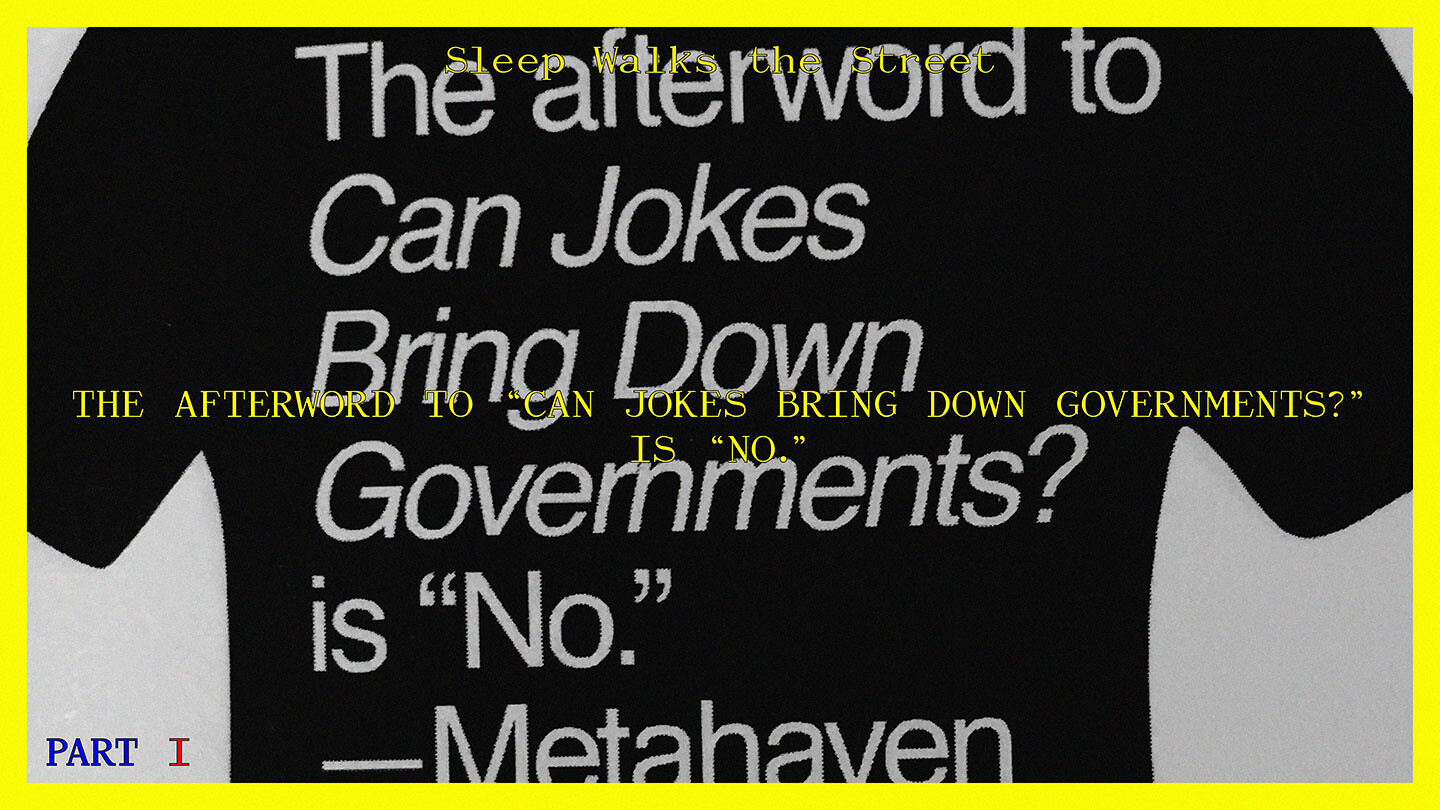

Our afterword to Can Jokes Bring Down Governments? (Strelka Press, 2013) as published in Ingo Niermann and Joshua Simon (eds.), Solution 275-294: Communists Anonymous (Sternberg Press, 2017).
Metaphor as Interface
Klemperer absolved most of his subjects of Nazi fundamentalism. Instead, he argued, it was all about those small doses of arsenic: the words themselves—the ways in which fallacies become repeated, then slowly but surely accepted as commonplace expressions. In Wekker’s anecdote, we find a white academic unable to face the possibility of a university dean being both good and black. The cognitive shortcut that appears in the academic’s response is backed up in words found in everyday Dutch language. Wekker mentions the pejorative excuustruus, the “female version of a token appointee.”6 Variations of this word also include excuusneger (“excuse ni**er”), a pejorative used in mainstream discourse in the Netherlands as recently as 2018 to indicate the black version of a token appointee.7
Though Klemperer does not point this out explicitly, many of the predominant motifs of Nazi rhetoric engendered metaphors, metonyms, and allegories that functioned to construct their own particular versions of reality, the enemy, and the world. Often mischaracterized as colorful or jokey language, all three of these rhetorical figures are essentially methods of disfiguration. Far-right politicians today take pride in their use of metaphor—especially when they incite violence. As recently as late September 2019, footage leaked of UK prime minister Boris Johnson defending his use of military metaphors around Brexit. Johnson exclaimed to a cheering crowd: “Do you think it’s okay for me to call [the European Union’s Brexit bill] the ‘surrender act’? Am I fighting a losing battle to use these military metaphors or should I stick to my guns?”8 Days earlier, Johnson had compared, at the UN General Assembly, the stretched-out Brexit process to the torment of Prometheus. This allegory had been reported upon as being “joking,”9 yet what concerns us here is the epistemological erosion that takes place through the near-constant replacement of realities with rhetorical manipulations, and their amplification. Rhetorical construction can take on the role of a cognitive placeholder, a closed caption or subtitle already formed and available to overlay the reality it refers to. We can say that the metaphors and other rhetorical figures in question are becoming more scalable, just as in the Nazi era, when they could influence what a whole country was and wasn’t thinking. As the politics of public space has been, by and large, replaced by the politics of digital platforms and smartphone apps, is it still correct to see metaphor, metonymy, and allegory as mere oratory instruments? Perhaps not. Indeed, they have exceeded the oratory purposes they had in city-states. Today’s pervasive planetary overlay of social media lends to them a role as interfaces with reality—understood narrowly, in Lev Manovich’s technical terms, as designating “ways to represent … and control the signal,” but also more broadly, as ways to format and constrain a public’s encounter with realities that are, at the same time as being represented, obscured.10 Political metaphor may be running afoul of us in ways not dissimilar to financial derivative products that triggered the 2008 financial crisis. Both rely on an ever-increasing distantiation between their “product” (derivative/metaphor) and “reality” while pertaining to the performative “realness” of the statement itself: in the case of the derivative, the obligation to pay; in the case of metaphor, the obligation to “deliver” the political reality that the rhetoric prescribes.
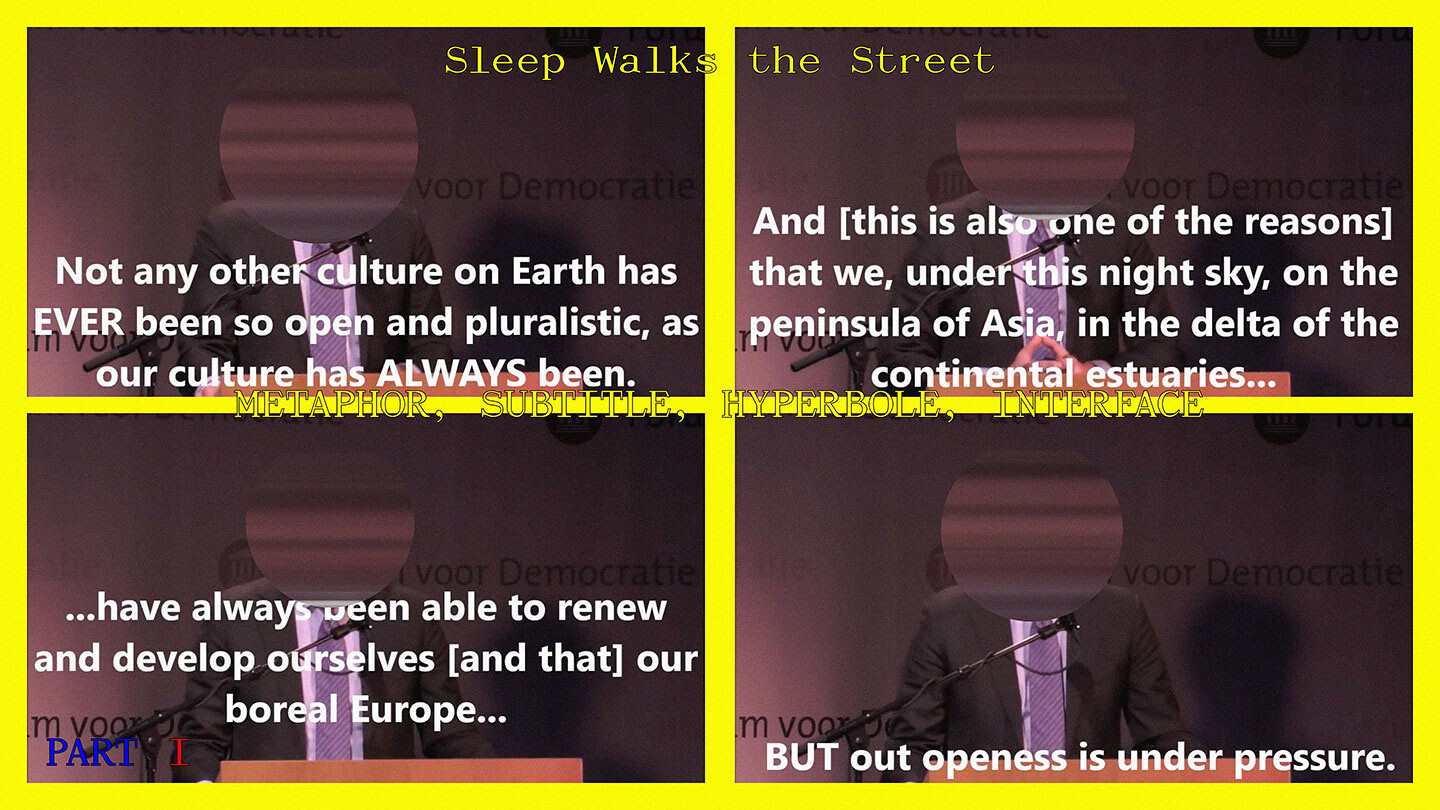

Dutch far right conservative politician Thierry Baudet, of Forum for Democracy (FvD), delivers a speech rife with doomsday metaphors, intensely subtitled on an associated YouTube account. Baudet, known for his close allegiance to far right and white supremacist figures, praises “boreal Europe,” a phrase with a long and notorious history within the European extreme right and its rhetorical apparatus. (Klemperer had observed the verb aufnorden (“to nordify”) being a Nazi term for changing the names of cities with Slavic or Lithuanian signatures into names that sounded “German,” see Language of the Third Reich, 83.)
Child’s Play
Is there a way out of this?
This essay is the first in a series concerned with this question. The title of the series—“Sleep Walks the Street”—is a quote from a children’s poem by the Russian author and absurdist poet Alexander Vvedensky (1904–41), whose work we will examine in Part 2.11 We are concerned with the (mistaken) reliance on constative and performative speech acts, and in that sense, with the mistaken reliance on language itself. We turn to poetic approaches that have attempted to work with this problem, often doing so under the duress of political and social turmoil. The epigraph of this essay—from Eugene Ostashevsky’s book-length poem The Pirate Who Does Not Know the Value of Pi—nicely summarizes the dilemma we find on our metaphorical path: “So we left language, but there was nowhere to go so we / came back.” In a conversation we had with him last year, Ostashevsky said something apparently straightforward in response to a question of ours on absurdist poetry: “People don’t say things because they believe them, they believe them because they say them.”12
Indeed, one of the things that “absurdism” did was to undermine the expediency of all language that was meant to be believed simply because it was uttered. This is still unwelcome politically, whether it is the “realism” of official Soviet aesthetics, the “promise” underlying a financial product, or the “organic truth” of Nazi ideologists like Alfred Rosenberg, or indeed whether it is the memes, metaphors, and allegories of the far and populist right that freely borrow from their ideological predecessors: all of these doctrines and “interfacial regimes” rely on believing their own performative phraseology. This is true whether such regimes are messy or systematic, whether centrally imposed or adopted as part of news cycles, troll and bot attacks, hashtags, likes, and retweets. Klemperer writes that the Third Reich, with its permanent accumulation of “historic” events and “momentous” ceremonies, was “mortally ill from a lack of the everyday.”13 Something similar seems to be the case with far-right leaders in Europe, whose speeches, whether delivered half-shouting or not, are swollen with rhetorical pomp that attempts to instill in the audience an idea of membership in some enormously important historical shift of tides. One way in which these speeches achieve their sense of inflated importance is by their heavy usage of metaphor.


Yet again.
Political Technologies
The cognitive scientist George Lakoff once explained that “the essence of metaphor is understanding and experiencing one kind of thing in terms of another.”14 Fredric Jameson has written about allegory in a similar manner, explaining that in it, “the features of a primary narrative are selected … and correlated with features of a second one that then becomes the ‘meaning’ of the first.”15 Indeed, conceptual substitutions of one thing for another thing can overwrite, and thereby erase, the possibility of an encounter with the first. Rather than being instances of clever wordplay to entertain or convince some Greek polis, metaphors, metonyms, and allegories have become scalable political technologies obfuscating, undermining, and instrumentalizing the realities they represent. Of course, the political expedience of metaphors has been well documented. Kateryna Pilyarchuk and Alexander Onysko assert that conceptual metaphors “help [political actors] to both direct and constrain the audience’s understanding by drawing on certain metaphorical themes.”16 Others have noted “the incredible potential of metaphor as a political tool.”17 But all this, while correct, is still understating what such linguistic operations comprise cognitively, and collectively, when supercharged by amplification on digital platforms. Rather than merely shifting a narrative frame, they tend to become the narrative. Some of this belongs to what is now sometimes called “memetic warfare,”18 which, by its very emphasis on “meme,” highlights the amplification and scalability aspects at the cost of taking into account the process of substituting fiction for reality (or of one story for another) that precedes the amplification.
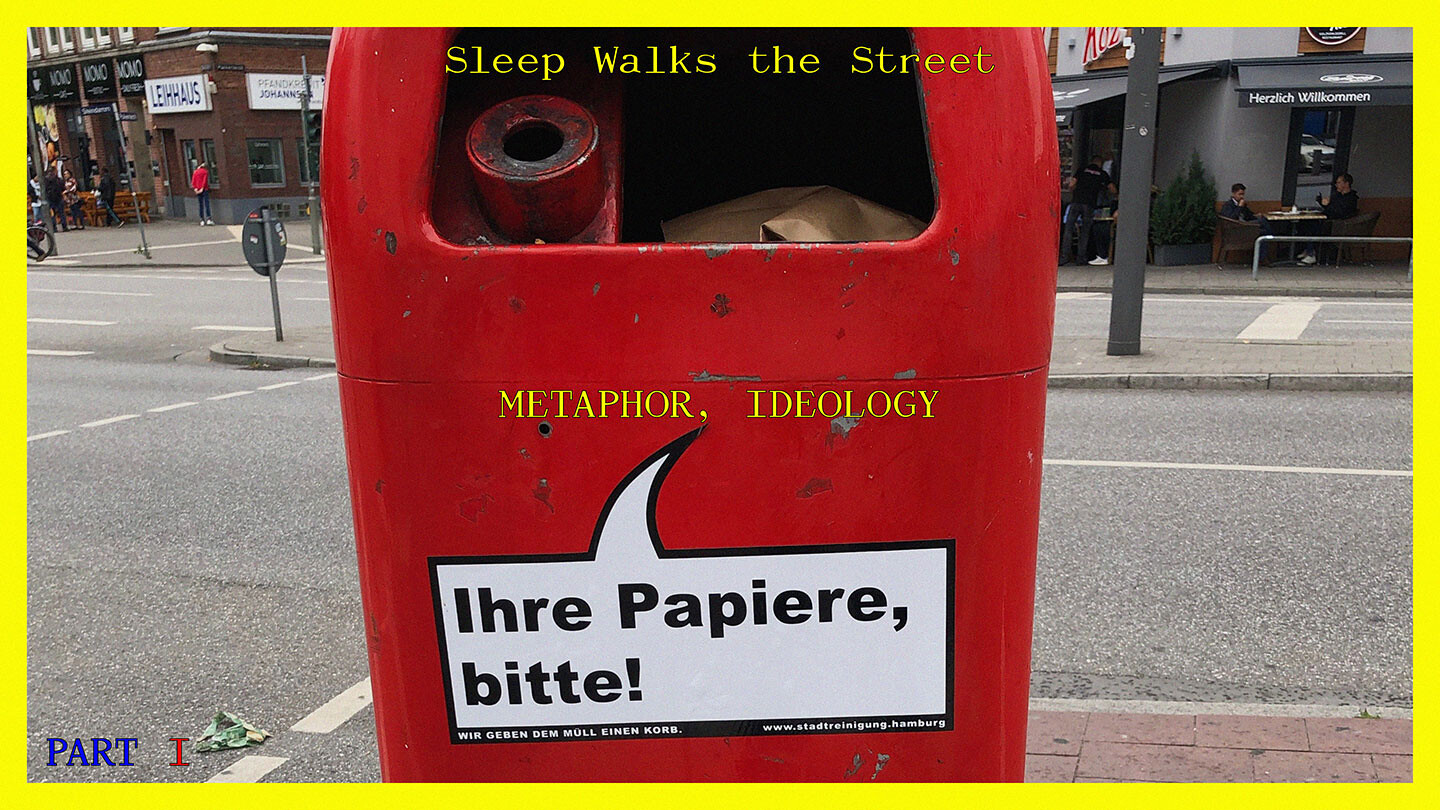

A trash can on the streets of Hamburg, Germany, 2019, is emblazoned with a text balloon that says “your papers, please!” The phrase—likely unwittingly—applies the coercive language of border crossings, ID checks, etc., as a recent (and relatively arbitrary) example of how ideological language transpires from one domain to another.
Your Last My Own Private Idaho Causality
Let us, for the time being, resort to an example from the Dutch far right. In the right-wing media space of Dutch news outlets, resentment about Islam is often expressed by the same audience that also “object[s] to climate hysteria,” which is what was formerly called climate-change denial. As a matter of ideological consistency, the same Twitter accounts that share Italian far-right demagogue Matteo Salvini’s beach selfies are also tend to hate the Swedish climate activist Greta Thunberg. The activities of trolls and bots aside, Islamophobic resentment in the Netherlands takes place with little to no actual knowledge about Islam or its practitioners; the same can probably be said about the level of knowledge regarding climate science. For a convincing assessment of the ways in which Dutch mainstream culture processes Islam’s otherness, Gloria Wekker’s White Innocence is invaluable—especially so the lengthy sequence devoted to the former politician Ayaan Hirsi Ali. Interested as Wekker is in “the self that constructs these hysterical, excessive, repressed projections,” we are interested in the self that creates (equally hysterical and excessive) cross-domain ideological consistency through metaphor.19 The mainstream Dutch right-wing newspaper De Telegraaf—notorious for its collaborative stance with the Nazis during World War II—recently soldered anti-Islamic resentment and climate-change denial together when, in its official reporting in 2019, it began to refer to windmills as klimaatminaretten (“climate minarets”). De Telegraaf didn’t invent the word. The far-right Freedom Party (PVV) of Geert Wilders appears to have coined it in or around August 2014; since then, specific credit for it has been given to the PVV politician Harry van den Berg.20 When used by the news media, it initially appeared only as a citation between quotation marks.21 But only two months after it was coined, the term was used without quotation marks by the Telegraaf-owned far-right “shockblog” Geenstijl.22 By 2015, an extreme-right Belgian politician amplified the term on Twitter.23
“Climate minarets” navigates its way through culture: beginning as fringe jargon, it eventually becomes a commonplace term in mainstream media.
Collapsing metaphor and metonymy to describe devices that collect and convert wind energy into electricity, “climate minarets” typifies a linguistic and cognitive short-circuiting that is as interfacially fundamentalist as it is rhetorically expedient for the demographic that likes its climate-change denial Nespresso with a touch of lactose-free Islamophobia. Tellingly, its far-reaching stupidity may belong to a backlash against the deafeningly idiotic technological lingo of “smart cities.” Yet under the aegis of free speech, phantasmatic concepts like “climate minarets” are exactly the ignes fatui—or “will-o’-the-wisp”—that Thomas Hobbes warned of when he discussed the danger of metaphors.24 Klemperer describes a factory foreman who used be a doctor, until the Nazis threw him out of his former job. Since then he has “appropriated all of the Nazis’ anti-Jewish expressions, and especially those of Hitler, and uttered them so incessantly that he himself could probably no longer judge to what extent he was ridiculing either the Führer or himself.” The foreman allows some members of his work group to use the tram, while others have to travel on foot, giving rise to the foreman’s distinction between “Fahrjuden (travel Jews) and Laufjuden (foot Jews).”25 A similar word construction can be detected in the vocabulary of the columnist-turned-politician Annabel Nanninga, a representative for the Dutch far-right Forum for Democracy (FvD) party. Nanninga referred to refugees drowning in the Mediterranean as dobbernegers (float ni**ers). In her original use of the word—in 2014—representative Nanninga called the “common dobberneger” by a fake Latin name, “Nigris flotillas vulgaris,” like an animal species.26 In a tweet posted on April 14, 2015—and since deleted—Nanninga wrote: “Illegalen en dobbernegers: we zijn te beschaafd dus ze blijven komen” (“Illegals and float ni**ers: we are too civilized, so they keep on coming”).27 Rather than performing on the level of expressing “opinion,” provoking “debate,” or enacting “free speech”—the levels at which a liberal politics conventionally assesses and classifies expressions such as these—the dobbernegers metaphor functions more like an interface. While its author (Nanninga) is absolved from any direct responsibility with regard to its ethics (because free speech, etc.), the word operates in a transformative relationship to its underlying epistemic reality. Just like klimaatminaretten, for the recipient the vacant space of knowledge, curiosity, or sensing is occupied with “ideas,” indeed heavily “interfacing” the now-overwritten, obscured epistemic reality with a particular “meaning.”
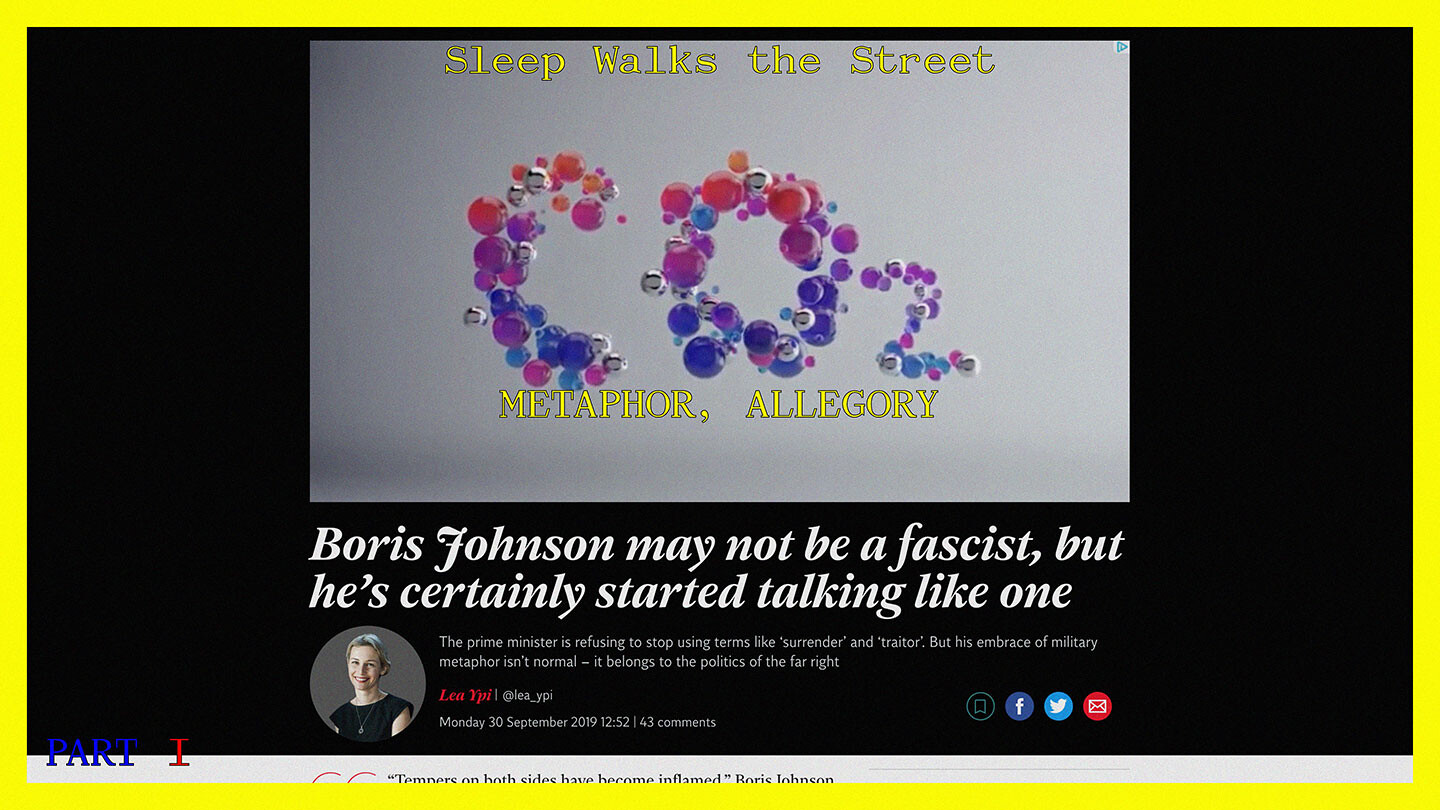

This page from The Independent website shows an ExxonMobil ad about “green energy by reducing C02 emissions out of fossil fuels” prior to footage of Boris Johnson, the current British PM.
Against the Precarity of Life, the Security of the Interface
The political effect of a term like dobbernegers is heavily predicated on its distribution through digital platforms. It appears as if it has been designed and tailored to interface with reality in compliance with the specific panel of instruments that users have when interacting with content and ideas on a digital platform. We will refer to this, as a whole, as an “interfacial regime”—a term coined by Benjamin H. Bratton in his 2016 book The Stack: On Software and Sovereignty. We use the term “interface” here in the same way as one would think of a software navigation panel or a dashboard—or for that matter, a radio host or AI persona that takes the place of a visual interface in the aural spectrum of interaction with computers. The idea that interfaces “have” “neutrality” is ludicrous, as any fan of Dieter Rams–designed radio sets will readily acknowledge, as will anyone who rated Spike Jonze’s 2013 film Her above-average. “The operating system may exist as an executable on disk, but it also exists phenomenologically as a metaphoric, cybernetic interface: the ‘desktop.’”28 Alexander Galloway’s characterization of operating systems appears to qualify the ways in which metaphors reach beyond accountability and move us into unknown realms with regard to the interface and its consequences. Indeed, “the fact that abstraction and figuration do exist in software (the interface metaphor of the ‘desktop’ as functional emanation of source code …) demonstrates the fundamental indeterminacy of a technological apparatus that is, admittedly, grounded in … deterministic mathematical language.”29
What happens in interfaces though, with their buttons and controls and their logistics, or their Elizas or Siris or Alexas, is perhaps the last form of direct causation that users will see happening in their lifetimes: against the precarity of life, the security of the interface. While generally unable to control income equality, pensions, the climate, wars, economic recessions, asteroids hitting objects in space including earth, the world resetting to its post-Permian state, tank battles, and many other things, our interactions with interfaces can cause digital objects and their “underlying” realities to be liked and disliked, blocked, muted, seen and unseen, ordered, eaten, ridden, unpacked, had, discovered, found, traced, wanted …
George Lakoff singled out, in a short 2016 assessment of metaphors used during the US presidential election, then-candidate Donald J. Trump’s preference for “direct causation” over “systemic causation.” There is a key parallel with the workings of the interface here. The comparatively more nuanced model of “systemic causation” recognizes chains of direct causes, interacting direct causes, feedback loops, and probabilistic causes contributing to a given situation. Acknowledging systemic causation or complexity does not give users the same primary satisfaction as having ordered an Uber, booked a flight, received a “like,” or received a new vacuum cleaner from Amazon. While systemic causation can explain things, it cannot create the same endorphin shot. According to Lakoff,
Systemic causation in global warming explains why global warming over the Pacific can produce huge snowstorms in Washington, DC: masses of highly energized water molecules evaporate over the Pacific, blow to the Northeast and over the North Pole and come down in winter over the East coast and parts of the Midwest as masses of snow.
He continues: “Many of Trump’s policy proposals are framed in terms of direct causation.” Indeed, here, in the logic of direct causation,
the cure for gun violence is to have a gun ready to directly shoot the shooter. To stop jobs from going to Asia where labor costs are lower and cheaper goods flood the market here, the solution is direct: put a huge tariff on those goods so they are more expensive than goods made here.30
Actions facilitated by interfaces, such as driving cars, ordering cab rides, paying for food, liking and disliking pictures and people and stories, voting (when it happens on a computer), and many more such actions, can only be done in tandem with processes of reduction. We suggest that in metaphor, metonym, and allegory, reality is not merely expediently manipulated to make a rhetorical point, but somehow also really lost. Klemperer noticed that during the Nazi era, there was an exponential growth of “technical expressions being applied to non-technical areas, in which they then function as a means of bringing about mechanization. In the German language this was only very rarely the case before 1933.”31 He asks:
Should it really be considered Romantic when Goebbels misrepresents a trip to the bombed cities in the west by claiming that he who had originally intended to instill courage in the victims had in the end himself been “recharged (neu aufgeladen)” by their unshakeable heroism?32
The ideology “inside” such language has become entirely commonplace to us. At every airport, we encounter curvilinear-shaped booths where we can “reboost” [sic] ourselves. The ideas of “recharging” or “resetting” our skin, of “recharging” our energies or youthful appearances—all of it is a long-lasting new normal to us. But we may well think of this as belonging to the longue durée of interfacial regimes. Summarizing the proliferation of metaphorical mechanical and technical terms instrumentalizing their underlying realities, Klemperer writes: “You can see and hear the button at work”—that is, the interface.33
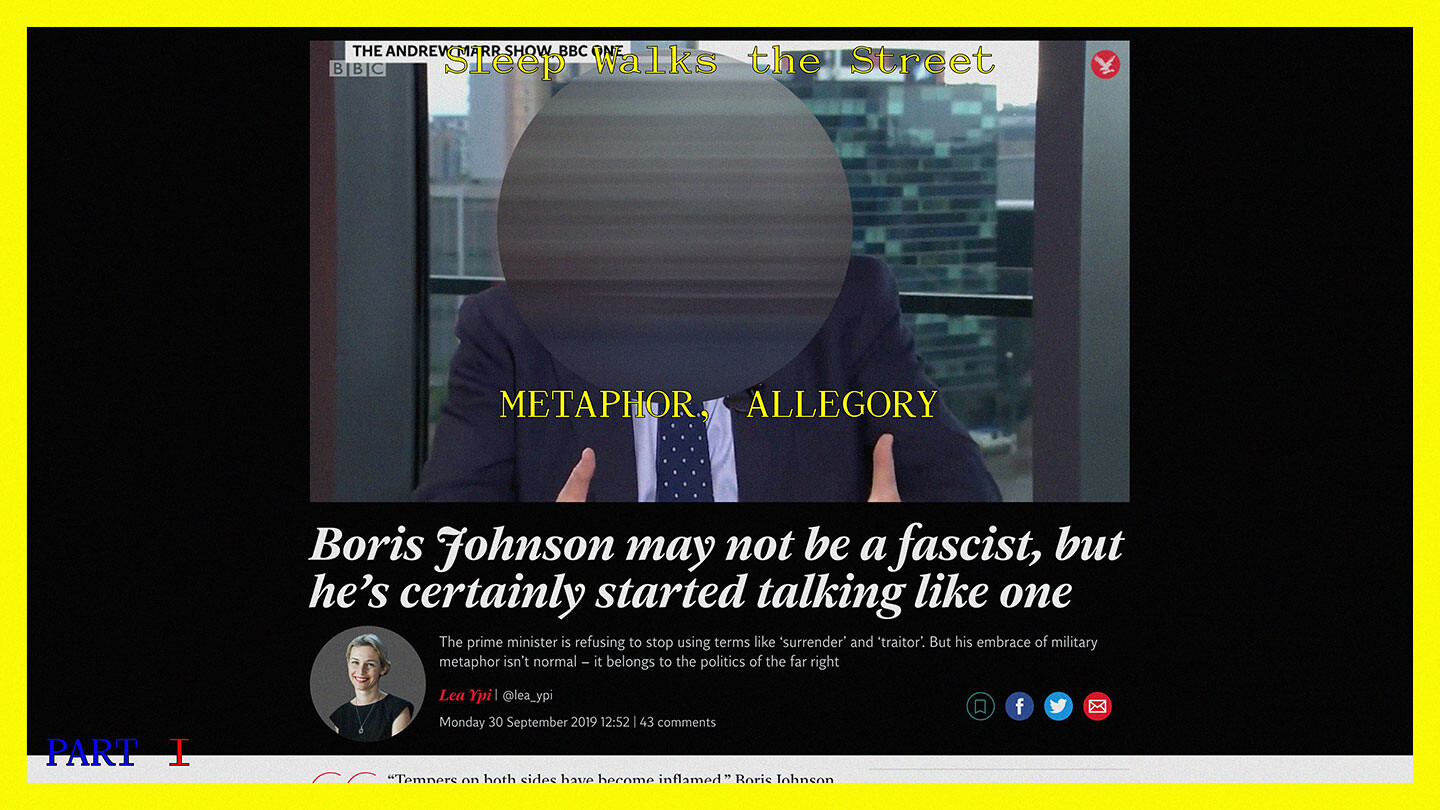

This page from The Independent website shows a video of Johnson gesturing. The article critiques Johnson’s usage of metaphors.
Bratton coins the term “interfacial regime” to denote a variety of ways in which interfaces constitute a political and ideological apparatus striving for consistency. While “the Interface layer describes the projective, perceptual cinematic, semiotic layer on a given instrumental landscape, including the frames, subtitles, navigable maps, pixelated hallucinations, and augmented realities through which local signification and significance are programmed,” its “power (and danger) is [the] remaking of the world through instrumentalized images of totality; it is what gives any interfacial regime even a politico-theological coherency and appeal.”34 This seems very much the case for the different computational platform ecologies “within which” information is deemed to be true or significant. Platforms such as Twitter, Facebook, and YouTube are all explicitly associated and involved with processes of political and ideological cognitive short circuiting—for example, through disinformation campaigns, hyper-targeted ads, trolls and bots, algorithmic suggestion and autoplay, as well as resultant “filter bubbles.” As such, they act as interfacial windows in which that which is visible passes for “the world.” And, according to Bratton, “as multiple interfaces congeal or are deployed as strategically particular interfacial regimes, they push toward naming everything that is visible to its scope.”35 In other words, some of the inhabitant objects of the interface are not so much its buttons and controls, nor its corporate colors and modes of display and interaction, but rather materials in them that bear on the interface’s potential to amplify and distribute—materials such as low-res image hoaxes, former forms of “satire,” remnants of archaic pasts, deepfakes, Salvini selfies, Trump’s hair, and clouds of words that settle in our collective memory only to erode it from inside. All of these, and all of them together, constitute a memetic-cognitive interfacial complex that deters users from further examining the hard-to-reach “underlying” materials. Hence, the subjects of our investigation, and participating factors in interfacial regimes, are not only words but also word-pictures, image macros, subtitled images, subtitles and closed captions themselves, and even words and images or their combinations as featured on the metaphorical “buttons” of apps and software platforms—thus, a field crossing from metaphor to meme to allegory to user interface. The engagement with mobile phones/smartphones as interfaces is relevant here structurally because they bring us interfacial realities that we cannot separate ourselves from without divorcing ourselves first from digital communication as a whole. The idea of the mobile phone itself, and what it means both metaphorically and physically to always carry its embodied ideas/metaphors with us, remains unexamined, principally because the connection that overloads us with metaphors has not yet been diagnosed as one that is epistemologically critical in cognitive terms.
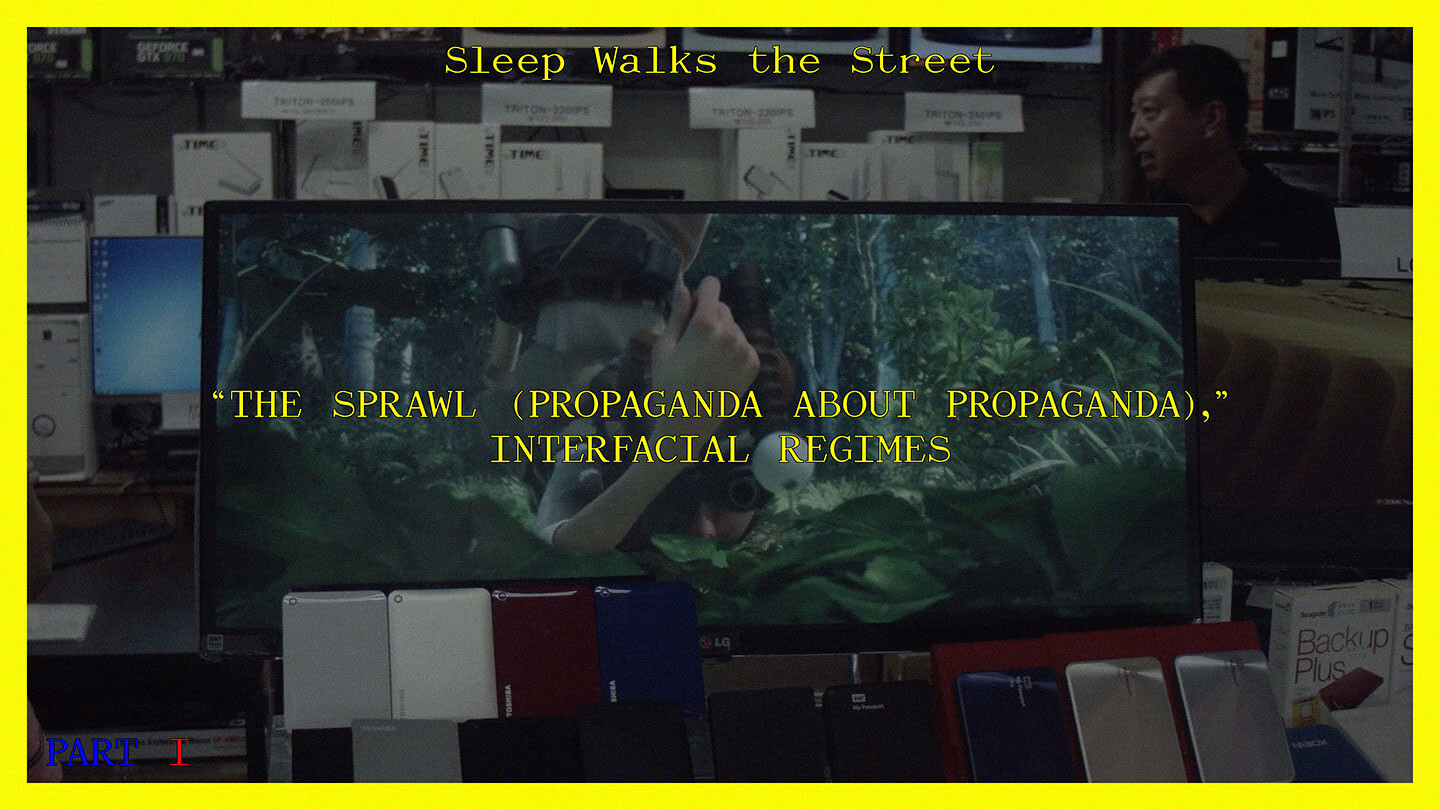

Augmented realities. Still from Metahaven, The Sprawl (Propaganda about Propaganda), 2015.
A further parallel can be drawn between interfaces as technological products using language, and techno-financial products whose operations are so unclear, yet complex, that they appear to “run away” with themselves, beyond their creators’ abilities to control them.
The media scholar Arjun Appadurai had identified the 2008 financial crash with the derailment of the “promise” at the heart of most gift rituals. Since this promise is a performative speech act and a key component of contracts and contract law, the reality of the promise—its keeping—is made “real” or actual by the performance. Appadurai’s assessment of the financial crisis is that of a “failure of language”—the language through which the promise is enacted. Appadurai sees the promise as an “illocutionary speech act that creates the reality it refers to by its very utterance.”36 By commanding the reality that it proclaims to exist, the promise becomes a precondition for further promises, in which dividuation (the separation of the whole into parts) plays a key role. Through partitioning and re-bundling, derivative financial products were promises chained to prior promises. Appadurai illustrates his claims by showing that the failure of language in the derivative mainly lay not in each individual promise made for a specific financial product, but rather in the chain of contracts that followed, in which there was increasing distance between initial contracts and derivatives built from it. Appadurai asserts that “any sequence of ritual action acquires its reverberative, amplificatory, and rippling effect on ordinary life by building on a series of links between things that resemble one another and things that are actually connected (as parts, components, or extensions) to one another.” He continues: “It is [the] ‘dynamic replication’ through metaphor and metonym that may be the most important way in which finance also achieves its amplificatory effects.”37


Analogy and allegory: “Ebola the ISIS of biological agents?” Still from Metahaven, The Sprawl (Propaganda about Propaganda), 2015.
Are Metaphors Too Big to Fail?
What if (political) language itself, supercharged via its social media amplifiers, is going the way of the derivative—the credit default swaps that, as Appadurai claims, brought the economy down in 2008 through the “failure” of its metaphors? As we will see in Part 2 of this essay series, for Eugene Ostashevsky, as well his predecessors in the Russian poetry group OBERIU (the Union for Real Art), there could not have been a “true” or “real” promise at all. Strikingly, at moments of structural political change, and in the historical context of seismic ideological and political shifts, artists as well as scholars have aimed to question language itself and hence its relationship to reality, ridiculing the performance of rhetorical gesturing to then have one’s telos and eat it too—and in the processes of lyrical ridicule and negation, ending up, paradoxically, in premodern philosophical territory. Whether documentary, absurdist, or lyrical in approach, what holds these practices together are acts of disbelief in the stated constative and performative functions of concepts and words. Klemperer wrote his Language of the Third Reich in an involuntary banishment from society. Indeed, he made his most striking observations only after the Second World War, when, resuming his teaching job, he met many young people in his classroom who wanted to get away from Nazism, but were unable to do so, as their language was still imbued with its expressions. Thus, the language of the Nazis was prolonged long after the regime was supposedly over and done with. Today, there is ample proof that it never went away.
The Language of the Third Reich’s very partial systematicity is also its undeniable strength. A diary—the blueprint for the book—would become its writer’s lifeline, indeed showing how in a situation of utter despair, nothing could stop him from beginning again and taking in all that was necessary to document and remember during the moment itself. The diary was
a balancing pole … without which I would have fallen down a hundred times. In times of disgust and despondency, in the dreary monotony of endless routine factory work, at the bedside of the sick and the dying, at grave-sides, at times when I myself was in dire straits … and when my heart was literally breaking—at all these times I was invariably helped by the demand that I had made on myself: observe, study and memorize what is going on—by tomorrow everything will already look different, by tomorrow everything will already feel different; keep hold of how things reveal themselves at this very moment and what the effects are.38
Victor Klemperer, The Language of the Third Reich, trans. Martin Brady (Bloomsbury Academic, 2013), 15.
Klemperer, Language of the Third Reich, 86.
The term “arts of noticing” appears in Anna Lowenhaupt Tsing’s 2015 book The Mushroom at the End of the World as a way to describe one’s perception of the environment under precarious circumstances. It applies to Klemperer’s methods of observing and subsisting amid the Nazi context. No longer able to carry out knowledge-gathering and knowledge-production from a position of privilege (such as an academic post), Klemperer’s mode of observing and writing is fundamentally touched by precarity and scarcity, as is the necessity to maintain brittle bonds with others whose political beliefs are sometimes all but certain.
Klemperer, Language of the Third Reich, 98.
Gloria Wekker, White Innocence: Paradoxes of Colonialism and Race (Duke University Press, 2016), 74.
Wekker, White Innocence, 74.
In 2013, television host Humberto Tan, after having been invited to host a late-night talk show on Dutch commercial network RTL, defended himself against being called an excuusneger. See → (in Dutch). As late as 2018, fashion entrepreneur Olcay Gulsen criticized the Dutch television system for being too white, pointing at the presence of merely a single excuusneger on its channels. See → (in Dutch). In saying so, Gulsen unwittingly affirmed that the perpetuation of a racist term can happen independently of political views—something Klemperer set out to prove in his book. The idea that words like excuusneger amount to racism has, strangely, been subject to denial, perpetuating the idea that race and racism are at play in all former colonial powers except the Netherlands—as Wekker points out, “essentially by acclamation, because we say that is the case.” See Wekker, White Innocence, 79.
See →.
See →.
Lev Manovich, Software Takes Command (Bloomsbury, 2013), 155.
As we will see in more detail in Part 2, the term “absurdism” does not entirely cover what Vvedensky and his artistic contemporaries were doing both artistically and philosophically.
Metahaven, “Pirates, Parrots, Poetry: Conversation with Eugene Ostashevsky,” in PSYOP: An Anthology, eds. Metahaven and Karen Archey (Koenig Books, 2018), 78.
Klemperer, Language of the Third Reich, 45.
George Lakoff and Mark Johnson, Metaphors We Live By (University of Chicago Press, 1980), 5.
Fredric Jameson, Allegory and Ideology (Verso, 2019), 4–5.
Kateryna Pilyarchuk and Alexander Onysko, “Conceptual Metaphors in Donald Trump’s Political Speeches: Framing his Topics and (Self-)Constructing his Persona,” Colloquium: New Philologies 3, no. 2 (2018).
Bryan Meadows, “Distancing and Showing Solidarity via Metaphor and Metonymy in Political Discourse: A Critical Study of American Statements on Iraq During the Years 2004–2005,” Critical Approaches to Discourse Analysis across Disciplines 1, no. 2 (2007).
Jacob Siegel, “Is America Prepared for Meme Warfare?” Motherboard, January 31, 2017 →.
Wekker, White Innocence, 11.
See → (in Dutch).
See → (in Dutch).
See → (in Dutch).
See → (in Dutch).
Indeed, “Metaphors, Tropes, and other Rhetoricall figures” may be “lawfull to say,” yet “in reckoning, and seeking of truth, such speeches are not to be permitted.” Thomas Hobbes, Leviathan (Penguin Classics, 1982), 114–15.
Klemperer, Language of the Third Reich, 199.
See → (in Dutch).
“Annabel Nanninga, lijsttrekster FvD Amsterdam,” →.
Alexander R. Galloway, The Interface Effect (Polity, 2012), 72.
Galloway, The Interface Effect, 74.
George Lakoff, “No One Knows Why Trump is Winning. Here’s What Cognitive Science Says,” Evonomics, 2016 →.
Klemperer, Language of the Third Reich, 157.
Klemperer, Language of the Third Reich, 160.
Klemperer, Language of the Third Reich, 159.
Benjamin Bratton, The Stack (MIT Press, 2016), 71, 229.
Bratton, The Stack, 229.
Arjun Appadurai, Banking on Words: The Failure of Language in the Age of Derivative Finance (University of Chicago Press, 2016), 149.
Appadurai, Banking on Words, 130.
Klemperer, The Language of the Third Reich, 10.

